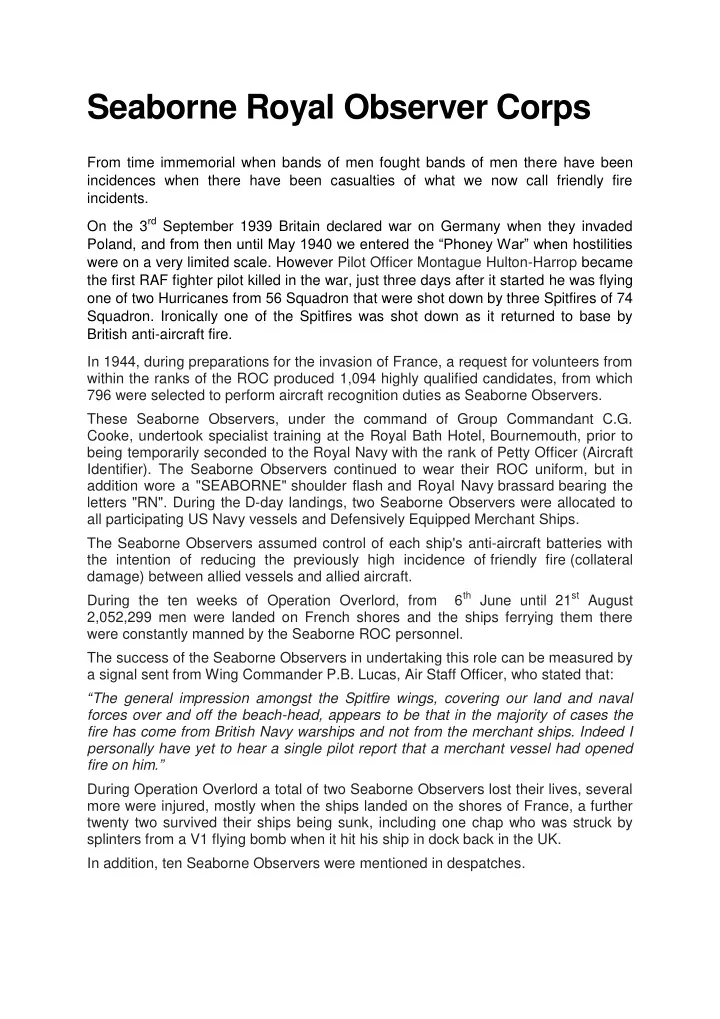

Seaborne Royal Observer Corps From time immemorial when bands of men fought bands of men there have been incidences when there have been casualties of what we now call friendly fire incidents. On the 3 rd September 1939 Britain declared war on Germany when they invaded Poland, and from then until May 1940 we entered the “Phoney War” when hostilities were on a very limited scale. However Pilot Officer Montague Hulton-Harrop became the first RAF fighter pilot killed in the war, just three days after it started he was flying one of two Hurricanes from 56 Squadron that were shot down by three Spitfires of 74 Squadron. Ironically one of the Spitfires was shot down as it returned to base by British anti-aircraft fire. In 1944, during preparations for the invasion of France, a request for volunteers from within the ranks of the ROC produced 1,094 highly qualified candidates, from which 796 were selected to perform aircraft recognition duties as Seaborne Observers. These Seaborne Observers, under the command of Group Commandant C.G. Cooke, undertook specialist training at the Royal Bath Hotel, Bournemouth, prior to being temporarily seconded to the Royal Navy with the rank of Petty Officer (Aircraft Identifier). The Seaborne Observers continued to wear their ROC uniform, but in addition wore a "SEABORNE" shoulder flash and Royal Navy brassard bearing the letters "RN". During the D-day landings, two Seaborne Observers were allocated to all participating US Navy vessels and Defensively Equipped Merchant Ships. The Seaborne Observers assumed control of each ship's anti-aircraft batteries with the intention of reducing the previously high incidence of friendly fire (collateral damage) between allied vessels and allied aircraft. During the ten weeks of Operation Overlord, from 6 th June until 21 st August 2,052,299 men were landed on French shores and the ships ferrying them there were constantly manned by the Seaborne ROC personnel. The success of the Seaborne Observers in undertaking this role can be measured by a signal sent from Wing Commander P.B. Lucas, Air Staff Officer, who stated that: “ The general impression amongst the Spitfire wings, covering our land and naval forces over and off the beach-head, appears to be that in the majority of cases the fire has come from British Navy warships and not from the merchant ships. Indeed I personally have yet to hear a single pilot report that a merchant vessel had opened fire on him .” During Operation Overlord a total of two Seaborne Observers lost their lives, several more were injured, mostly when the ships landed on the shores of France, a further twenty two survived their ships being sunk, including one chap who was struck by splinters from a V1 flying bomb when it hit his ship in dock back in the UK. In addition, ten Seaborne Observers were mentioned in despatches.
The deployment of Seaborne Observers was regarded as an unqualified success and in recognition for their contribution to the success of the landings, King George Vl approved the permanent wearing of the SEABORNE shoulder flash on the ROC uniforms of those individuals who had taken part. Following the invasion, and Air Chief Marshal Trafford Leigh-Mallory wrote a message which was circulated to all ROC personnel: “ I have read reports from both pilots and naval officers regarding the Seaborne volunteers on board merchant vessels during recent operations. All reports agree that the Seaborne volunteers have more than fulfilled their duties and have undoubtedly saved many of our aircraft from being engaged by our ships guns. I should be grateful if you would please convey to all ranks of the Royal Observer Corps, and in particular to the Seaborne observers themselves, how grateful I, and all pilots in the Allied Expeditionary Air Force, are for their assistance, which has contributed in no small measure to the safety of our own aircraft, and also to the efficient protection of the ships at sea. The work of the Royal Observer Corps is quite often unjustly overlooked, and receives little recognition, and I therefore wish that the service they rendered on this occasion be as widely advertised as possible, and all units of the Air Defence of Great Britain are therefore to be informed of the success of this latest venture of the Royal Observer Corps. ” Seaborne Observers remain the only members of the ROC whose service during World War II entitled them to wear the HM Armed Forces Veterans Badge, their qualifying for such resulting from the approximately ten-week period of secondment to the Royal Navy. (The ROC itself was never a component of HM Armed Forces; ROC members being non-combatants during wartime with the exception of full-time officers who could be armed and therefore legally classed as combatants)
ROC D-Day Roll of Honour Killed in action: Chief Observer John B. Bancroft* (Motor Vessel Derry Cunily 24 June 1944 – sunk by acoustic mine); Observer Bill Salter (Steam Ship Empire Broadsword sunk by a mine). Mentioned in despatches: Observer Lieutenant George Alfred Donovan Bourne ; Leading Observer Joseph Douglas Whitham ; Observer Thomas Henry Bodhill ; Observer John Hughes ; Observer Derek Norman James ; Observer Edward Jones ; Observer Albert Edward Llewellyn ; Observer George McAllan; Observer Anthony William Priestly ; Observer John Weston Reynolds. .. and all the remainder of the 796 courageous volunteers! On a more positive note, Petty Officer’ Ian Ramsbottom (who must have been the youngest ‘Senior NCO’ in the Royal Navy for those ten weeks) returned safely back to school! Those of you who are able to stand easily, please raise a glass to the memory of all the Seaborne Royal Observer Corps personnel who took part in Operation Overlord. The Seaborne Royal Observer Corps.
Recommend
More recommend